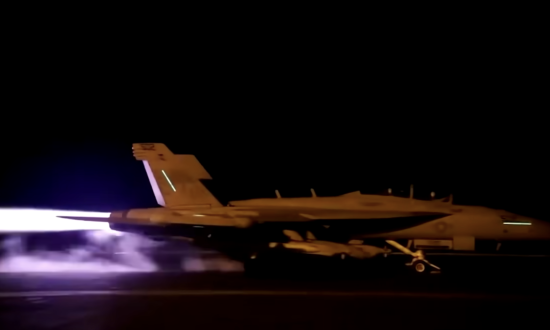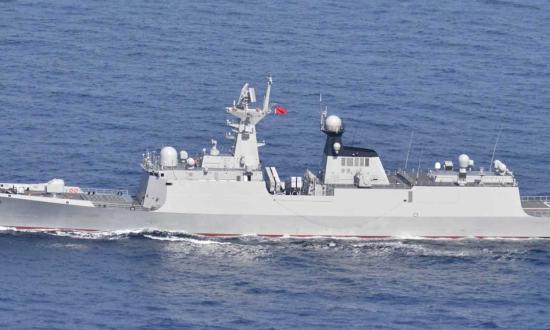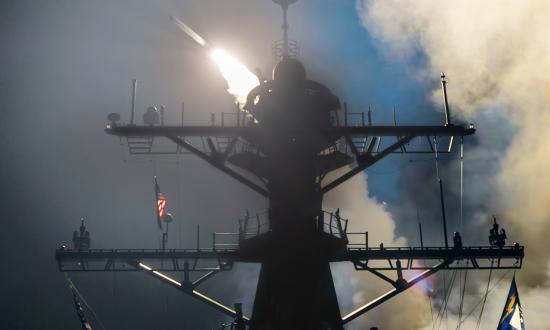Even though the Houthis of Yemen employ a narrow range of capabilities—primarily drones and missiles—they have created a dangerous kinetic environment from which the naval powers deployed in the region have gained sustained combat experience. For the United States, it is the most since World War II. This experience is especially relevant in today’s increasingly tumultuous international environment. While the Houthis are not in the same league as potential opponents such as China, recent events in the Red Sea provide important strategic-level learning opportunities.
Reaffirming the Importance of the Sea Lines of Communication
More than a century ago, Julian S. Corbett, a foundational naval strategic thinker, wrote that the value of the sea in the global political system “is as a means of communication between States and parts of States.”1 Corbett’s contemporary and competitor Alfred T. Mahan agreed, “The first and most obvious light in which the sea presents itself from the political and social point of view is that of a great highway; or better, perhaps, of a wide common, over which men may pass in all directions, but on which some well-worn paths show that controlling reasons have led them to choose certain lines of travel than others. These lines of travel are called trade routes.”2 Today, the Houthis sit astride a critical trade route that passes from the Gulf of Aden through the Bab el-Mandeb Strait to the Red Sea and eventually to the Suez Canal.
It is easy to forget the Navy’s essential role in protecting these maritime arteries. Consider Secretary of the Navy Carlos Del Toro’s testimony in April 2024: “In the Red Sea, as elsewhere, we must not hesitate to counter those who threaten the free and lawful use of the sea by all nations.” This is a necessity for global economic prosperity, for the disruptions in the Red Sea are having a global impact. Thus, the first and perhaps most important strategic-level lesson from the Red Sea is that this traditional naval mission remains essential.
Navies and Land-Based Threats
On 11 January, the United States and Britain with the support of several partners launched a series of air and missile strikes against 60 targets in 16 locations connected with Houthi attacks on maritime commerce. Additional attacks followed. These strikes have not stopped the Houthis. In fact, the captain of the French frigate Alsace, after operating in the region for an extended period, has concluded that their attacks are becoming increasingly sophisticated.
The objective for the naval powers in the Red Sea entails maintaining the free flow of commerce, but the Houthi and their weapons are based on land, not at sea. This has forced the naval powers to employ what Corbett labeled “direct territorial attacks.”3 The naval powers are finding their strength dissipates quickly when they attempt to obtain strategic effects ashore even though the Houthis do not appear to possess a modern air-defense network, and the naval powers have air supremacy. Moreover, the United States has been able to exert additional pressure by being able to safely deploy an aircraft carrier strike group in the Red Sea. Yet, Houthi attacks persist. Events in the Red Sea demonstrate there are limits to what navies can do to stop land-based attacks aimed at sea denial by even a relatively weak power relying on a narrow range of unmanned systems.
Coalition Partners and Naval Operations
In today’s increasingly competitive maritime environment, the United States has come to rely on global partnerships. It is not surprising that it has sought the assistance of partners in the Red Sea. To this end, Operation Prosperity Guardian was announced in December 2023 “to jointly address security challenges in the southern Red Sea and the Gulf of Aden, with the goal of ensuring freedom of navigation for all countries and bolstering regional security and prosperity.”
As Houthi attacks escalated, the United States, Britain, and several other partners began carrying out strikes on land targets in Yemen. Though the strikes are not part of Prosperity Guardian (they comprise the U.S. Central Command operation Poseidon Archer), they have complicated relations among the naval partners in the region. Several members of the European Union, including France, Italy, and Spain, have decided to remain entirely on the defensive. To that end, the European Union stood up Operation Aspides, named after the ancient Greek word for “shield.” According to a spokesperson, “Aspides will not conduct any operation on land—only at sea, in a purely defensive mode.” While these states agreed with the basic objectives of Prosperity Guardian, Operation Aspides suggests they are worried that strikes ashore are escalatory and that being associated with them could draw them deeper into the regional conflict.
All this makes operations at sea more difficult. Even though the naval powers have similar objectives, their means of obtaining those objectives differ significantly. As a result, partners are conducting different missions in the same region under different rules of engagement. Fortunately, the Houthis have employed only a narrow range of drones and missiles, but even in this environment, it has proven difficult to coordinate operations. For example, in late February 2024, a report surfaced that a German frigate accidently targeted a U.S. MQ-9 Reaper drone.
What is occurring at the diplomatic level appears to be relatively clear in the available news reporting. This is especially the result of the European Union, which has been forthright in announcing that they have different ways of obtaining their objectives than the United States.
How this is all playing out at sea is far less transparent. Mahan, writing more than a century ago, was skeptical about the viability of maritime partnerships. He asserted, “Each party to an alliance usually has its particular aim, which divides action.”4 This is made more complex by the need to integrate capabilities while working in an unforgiving environment. The Red Sea provides a powerful lesson on the challenges, even over short periods, of sustaining naval partnerships.
Missions and the Number of Warships
There have been many discussions about how many ships the U.S. Navy should possess. Some compare the size of fleets and argue the United States is falling behind, while others contend numbers are less important than warship capabilities. There is truth in both arguments, but there is another factor that is often forgotten: commitments and missions can be more meaningful in determining the optimal size of the fleet. The more a navy must accomplish, the greater the number of ships it should possess. Moreover, even the most capable ship cannot be in two places at once. While some things can be done today with drones and aircraft, there is often nothing as effective as the presence of a warship.
Operations in the Red Sea also underscore the stress of putting at risk a navy’s finite number of warships and their crews. This is not just a United States issue; it is even more acute among the smaller fleets of its partners. The commander of HMS Diamond explained, “The levels of concentration [are] exhausting, long periods of nothing much happening, and then a few really short intense spikes of your life being at risk.” It is not only about having enough ships and people to sustain initial deployments. Combat is stressful. Replacements are necessary. Crews need time to decompress, and warships time to be repaired and rearmed.
Moreover, ships can be damaged or lost. Corbett wrote, “We cannot make war without losing ships.”5 Though he was describing merchant shipping, both he and Mahan understood that when ships are put in harm’s way, there is always risk. Though both wished to minimize bad things from happening, if a navy counts on obtaining its objectives without loss, this creates dangerous expectations among political leaders, navy personnel, and the general public. As Anthony Cowden recently explained, some attacks will eventually get through.
A year ago, few would have expected the need for the United States to sustain operations in the Red Sea involving a substantial number of warships including a carrier strike group. Though the pacing threat is China, the world will not stand still while the United States merely competes against that one challenger. The lesson is stark: naval powers require the numbers to flex globally and sustain operations where threats persist.
The Importance of Learning
Events in the Red Sea have put the essential naval mission of maintaining the security of the sea lines of communication into focus. They have reiterated the difficulty, even with modern technologies, of using navies to influence events ashore. It is a reminder that working with naval partners will never be easy, and in a kinetic environment, this only becomes more difficult. Operations in the Red Sea also have provided a powerful reminder for the need to balance the size of a navy with its commitments and having the ships to sustain operations to meet the missions of both today and tomorrow. The international environment is tumultuous, replete with risk. Recent events have given the naval powers involved an opportunity to be introspective, so they can think more strategically about the future.
1. Julian S. Corbett, “Green Pamphlet,” included as an appendix to Some Principles of Maritime Strategy (Annapolis, MD: Naval Institute Press, 1988), 317.
2. Alfred T. Mahan, The Influence of Sea Power upon History, 1660–1783 (Boston: Little, Brown, 1890), 25.
3. Corbett, “Green Pamphlet,” 317–18.
4. Alfred T. Mahan, Naval Strategy Compared and Contrasted with the Principles and Practice of Military Operations on Land (Boston, MA: Little, Brown, 1911), 43.
5. Corbett, Some Principles of Maritime Strategy, 279.






